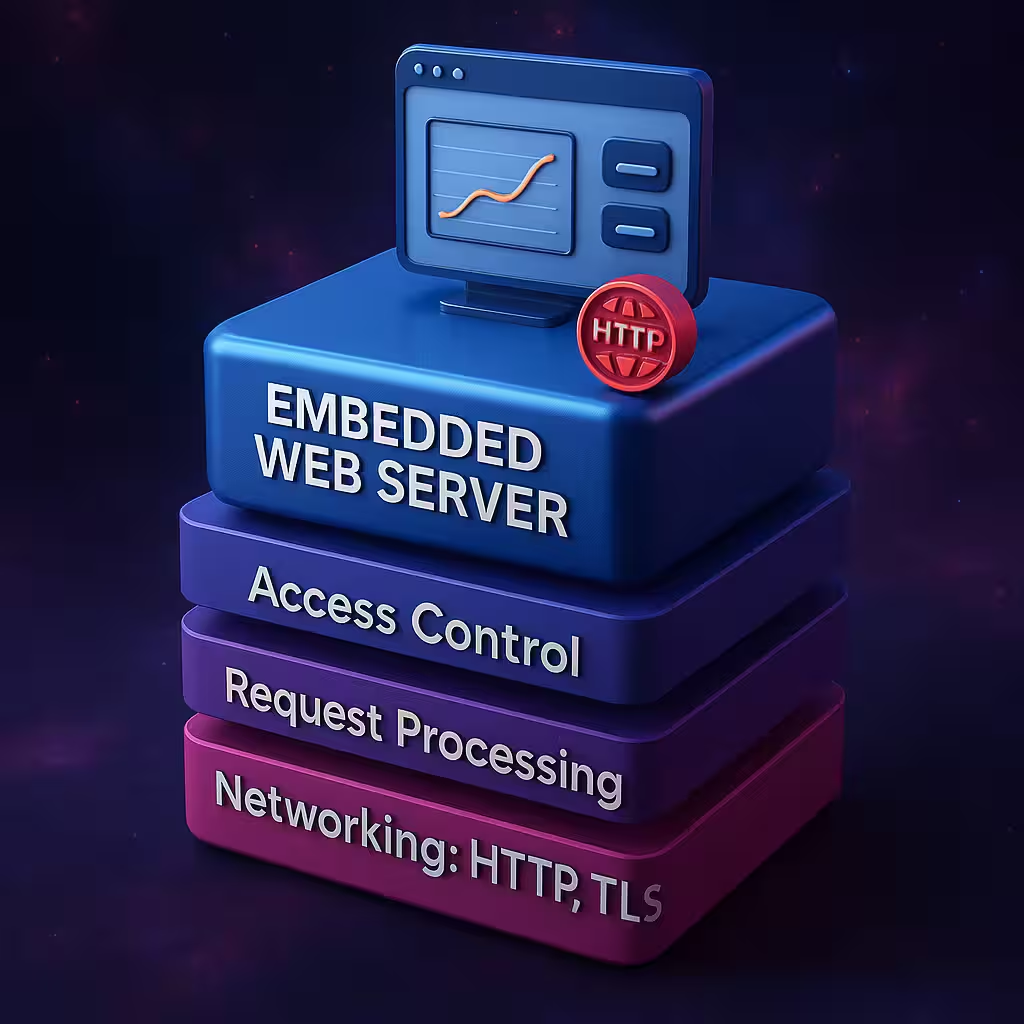What is an Embedded Web Server?

An embedded web server is a compact HTTP server designed to run within resource-constrained devices, providing web-based management interfaces and connectivity for IoT devices, industrial equipment, and consumer electronics. It allows users to monitor, configure, and control devices through standard web browsers over a network connection.
Why Use an Embedded Web Server?
Lightweight Operation - Embedded web servers are designed to be lightweight and efficient, making them ideal for resource-constrained devices and microcontrollers.
Universal Access - The primary advantage is providing access from any device with a web browser, enabling direct device management without specialized software or specific operating systems.
Reduced Development Costs - By leveraging standard web technologies (HTML, CSS, JavaScript), developers can create sophisticated interfaces using widely available skills instead of developing platform-specific applications.
Remote Management - Embedded web servers enable remote device monitoring, configuration, and troubleshooting, reducing the need for physical access and field service visits.
Scalability and Flexibility - Web interfaces can scale from simple status pages to complex management applications, adapting to the varying capabilities and requirements of different devices. The use of Single Page Applications and Progressive Web Apps allows for a rich user experience with minimal latency and bandwidth.
Integration Capabilities - HTTP-based communications facilitate integration with other systems, cloud services, and enterprise applications through standard web protocols.
Security Control - Modern embedded web servers provide authentication, encryption, and role-based access control mechanisms to secure device access and protect sensitive operations.
Features of an Embedded Web Server
Most embedded web servers share the following core capabilities:
| Feature | Description |
|---|---|
| HTTP Support | Implementation of HTTP/HTTPS, WebSockets and SSE protocol to serve web content and process client requests. |
| Content Delivery | Serving static files (HTML, CSS, JavaScript) and dynamically generating content based on device state and user interactions. |
| Device Apps | Support for embedded applications that deliver dynamic content and expose real-time device state and control. |
| Security | Authentication, encrypted communications (TLS/SSL), and user access control mechanisms to protect device access and operations. |
| API Support | REST APIs, WebSockets, SSE, and other interfaces enabling programmatic device interaction and third-party integration. |
| Device Provisioning | Secure configuration and setup of the embedded web server including credential management, network settings, and access control. |
| Device Management | Web-based interfaces for configuration, monitoring, diagnostics, and control of the underlying hardware. |
| Cross-Platform | Ability to run on various embedded operating systems and hardware platforms without modification. |
| Small Footprint | Optimized code size and memory usage for operation in resource-constrained environments, typically requiring under 1MB of memory. |
Modern Embedded Web Servers
More modern embedded web servers, like EmbedThis Ioto, go further by including an embedded device database, an HTTP Client, support for MQTT cloud connectivity, JSON-based state management and data exchange, and secure over-the-air (OTA) software and firmware updates.
Embedded Web Server Comparison
Here’s a comparison table showing the key features across three embedded web servers by EmbedThis.
| Feature | Ioto | GoAhead | Appweb |
|---|---|---|---|
| Code Size | 300KB | 500KB | 2MB |
| Programming Model | Fiber coroutines | Single threaded | Multithreaded |
| HTTP/1.1 Server | ✓ | ✓ | ✓ |
| HTTP/2 Protocol | ✓ | ||
| HTTP Client | ✓ | ✓ | |
| WebSockets | ✓ | ✓ | |
| IPv4 and IPv6 | ✓ | ✓ | ✓ |
| Server-Sent Events (SSE) | ✓ | ||
| C function Actions | ✓ | ✓ | ✓ |
| SSL/TLS | ✓ | ✓ | ✓ |
| HTTP Proxy | ✓ | ||
| File Upload and PUT requests | ✓ | ✓ | ✓ |
| Authentication and User Management | ✓ | ✓ | ✓ |
| Session and Cookie Handling | ✓ | ✓ | ✓ |
| OTA Updates | ✓ | ✓ | ✓ |
| Embedded Database | ✓ | ||
| JSON Data Exchange | ✓ | ||
| Bundled Management Apps | ✓ | ||
| MQTT client | ✓ | ||
| Full-Duplex streaming | ✓ | ||
| CGI / FastCGI | ✓ | ✓ | |
| Cloud Integration | ✓ | ||
| Device Data Synchronization | ✓ | ||
| Throughput (Raspberry Pi 4) | 9,300/sec | 3,200/sec | 1,800/sec |
Conclusion
Embedded web servers represent a critical technology for modern connected devices, bridging the gap between hardware functionality and user interaction through familiar web interfaces. By enabling standard web protocols on resource-constrained devices, they provide the foundation for direct device management and secure device operation.
Modern IoT device agents combine local embedded web servers for direct on-device management with cloud-protocols like MQTT for secure, remote device management.
{{comment.name}} said ...
{{comment.message}}